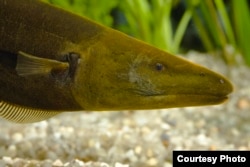Electric fish, which have electric receptors in their skin that serve as a kind of radar system to help them navigate, communicate and locate food and mates, could provide insight into how our own central nervous system works.
Electric fish live mostly in fresh water in tropical rivers and are found primarily in only two parts of the world.
There are two main groups, one in South America, the Gymnotiform, and that’s about 200 species that are known," said Rudiger Krahe, associate biology professor at Canada’s McGill University. "And then there is a second group in Africa, the Mormyri fish, and there are also about 200 species.”
These two groups evolved independently, yet share the same ability to generate and sense weak electric waves. Their electric fields can be recorded with simple devices that pick up the signals in the water.
“We can observe electrically, observe the activity of these fish continuously because they produce these signals non-stop, day and night," Krahe said. "And so we can monitor what they do, what their signals look like, how they modulate them in different context such as communication and then we can play them back artificially to them in experiments.”
While humans never developed this electric sense, our nervous system processes signals from our environment in much the same way as these fish do.
“How information is transmitted, how different aspects of the sensory information are extracted, that’s extremely similar to what happens in the auditory systems, so, in our hearing, and also, in many ways, what happens in vision,” Krahe said.
Fish don’t have brains nearly as complicated as humans, but many of the structures and pathways are quite similar. That link offers a new approach to understanding human physiology.
“How we extract sensory information, how we use that to guide our behavior, how our nervous system accomplishes that and of course we do experiments with fish that we cannot do with humans," Krahe said. "And we’re trying to learn general principles of nervous system action, basically, and how behavior is controlled. ”
This research could be applied in studies on the impact of serotonin, a hormone in the central nervous system believed to influence mood and depression.
Electric fish live mostly in fresh water in tropical rivers and are found primarily in only two parts of the world.
There are two main groups, one in South America, the Gymnotiform, and that’s about 200 species that are known," said Rudiger Krahe, associate biology professor at Canada’s McGill University. "And then there is a second group in Africa, the Mormyri fish, and there are also about 200 species.”
These two groups evolved independently, yet share the same ability to generate and sense weak electric waves. Their electric fields can be recorded with simple devices that pick up the signals in the water.
“We can observe electrically, observe the activity of these fish continuously because they produce these signals non-stop, day and night," Krahe said. "And so we can monitor what they do, what their signals look like, how they modulate them in different context such as communication and then we can play them back artificially to them in experiments.”
While humans never developed this electric sense, our nervous system processes signals from our environment in much the same way as these fish do.
“How information is transmitted, how different aspects of the sensory information are extracted, that’s extremely similar to what happens in the auditory systems, so, in our hearing, and also, in many ways, what happens in vision,” Krahe said.
Fish don’t have brains nearly as complicated as humans, but many of the structures and pathways are quite similar. That link offers a new approach to understanding human physiology.
“How we extract sensory information, how we use that to guide our behavior, how our nervous system accomplishes that and of course we do experiments with fish that we cannot do with humans," Krahe said. "And we’re trying to learn general principles of nervous system action, basically, and how behavior is controlled. ”
This research could be applied in studies on the impact of serotonin, a hormone in the central nervous system believed to influence mood and depression.












